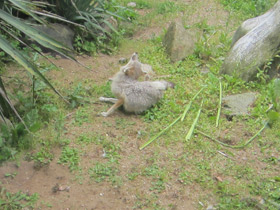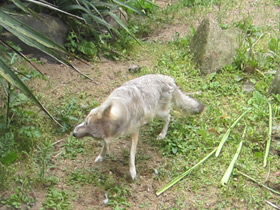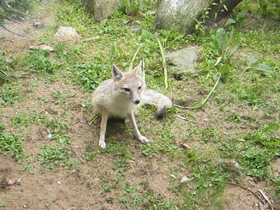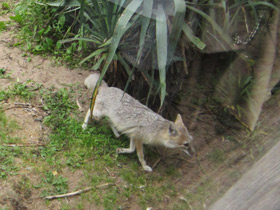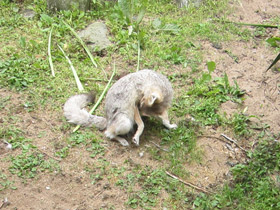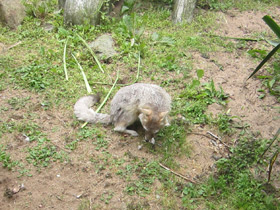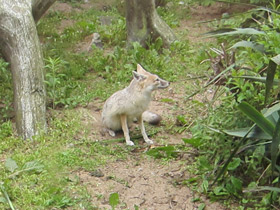The swift fox (Vulpes velox)
The swift fox (Vulpes velox) is a small light orange-tan fox around the size of a domestic cat found in the western grasslands of North America, such as Montana, Colorado, New Mexico, Kansas, Oklahoma and Texas. It also lives in southern Manitoba, Saskatchewan and Alberta in Canada, where it was previously extirpated. It is closely related to the kit fox (Vulpes macrotis) and some mammalogists classify them as conspecific. However, molecular systematics imply that the two species are distinct. Interbreeding between the two species does occur where their ranges overlap (eastern New Mexico and western Texas), but this hybridization is quite restricted in scope.
The swift fox lives primarily in short-grass prairies and deserts. It became nearly extinct in the 1930s as a result of predator control programs, but was successfully reintroduced later. Currently, the conservation status of the species is considered by the IUCN as Least Concern owing to stable populations elsewhere.
Like most canids, the swift fox is an omnivore, and its diet includes grasses and fruits as well as small mammals, carrion, and insects. In the wild, its lifespan is 3 to 6 years, and it breeds once annually, from late December to March, depending on the geographic region. Pups are born anywhere from March to mid-May, and are weaned at six to seven weeks old.
Appearance
Vulpes velox has many names: it is called American corsac, dwarf agile fox or prairie fox. In Latin, the species name velox means "swift". This small corsair is much smaller than the well-known red fox: its length varies from 37 to 53 cm, its height at the withers is about 30 cm and its weight is 2-3 kg. On the other hand, it has larger ears, a shorter and wider muzzle, and a totally different colour: light grey with a reddish tinge on the sides and legs; lighter on the abdomen and throat. Its coat is dense, but not long.
Habitat
Vulpes velox was originally found in open grassy plains and deserts from southwestern Canada through the Great Plains to Texas. However, it became totally extinct in Canada in the 1930s, but persists in the United States east of the Rocky Mountains. One of its subspecies is found in the United States west of the Rocky Mountains in Arizona, Utah, Nevada and southern California. Vulpes velox lives in open, low grass prairies, grassy plains and dry semi-deserts.
Lifestyles
In summer it is active at dusk and at night; in winter it may also bask during the day. They wait out the summer heat or windy days in deep, long underground burrows, which are often dug into hillsides. On rare occasions, foxes occupy the empty burrows of badgers or moles. Each raptor usually has several dens (up to 13). These animals are not territorial and do not mark the boundaries of their 1.5 to 5 km² home ranges.
Behaviour, nutrition and reproduction
Recent studies have shown that the social organisation of Vulpes velox is unusual for canids: females remain and guard the patches, while males relocate if a permanent female is removed from the patch. This may be due to the fact that male Vulpes velox play a lesser role in rearing young than males of many canids, as in summer, when the young are growing, Vulpes velox feed mainly on insects (in particular beetles, grasshoppers and locusts, which constitute up to 50% of their diet). In other seasons, these foxes feed on various rodents, rabbits, ground-nesting birds, reptiles and fruits. In winter, carrion is an important source of food. These animals are very stealthy and fearful, and in case of danger they flee very fast, reaching speeds of up to 60 km/h and easily changing direction, hence their name, the "swift fox".
Vulpes velox form stable pairs. Cubs are born after 50-60 days of gestation and there are 3 to 6 cubs in a litter. Their eyes open between days 10 and 15 and they remain in the den until the end of the first month of life. Their mother feeds them with milk for 6-7 weeks and, at the age of three months, the cubs hunt with their parents. The family group separates only in September-October, when the young foxes go out to find their own patches. Males reach sexual maturity at one year of age; females reach sexual maturity later, at two years. Their lifespan in the wild is only 3-4 years; in captivity, these animals live up to 13 years.










